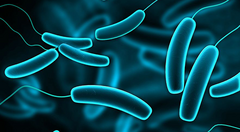Thursday, 07 July, 2016
Protein patterns – stubbornly stable
Biophysics
Control of the spatial distribution of specific proteins within cells is crucial for many biological processes. LMU researchers have now shown that, once such patterns have been set up, they are remarkably robust to changing conditions.
Inhomogeneous distributions of proteins are essential for the execution of many biological processes. For instance, the correct placement of certain proteins determines the plane of cleavage during cell division, and ensures the correct segregation of the chromosomes. Many cell types have characteristic forms, and their geometries can have a significant impact on intracellular protein patterning. However, cells are not static entities. They grow, divide and react to all manner of stimuli in ways that often involve changes in cell geometry. How biological patterns adapt to dynamic changes in cell form is largely unknown. But now a team led by LMU physicist Professor Erwin Frey and Professor Cees Dekker of Delft University of Technology in the Netherlands has studied protein patterns in growing cells, and shown that these are highly robust to alterations in cell morphology. Once established, a given protein distribution normally remains stable when the overall geometry of the cell changes. “This finding represents an important advance in our understanding of how dynamical patterns form, and will help us to elucidate fundamental questions in cell and developmental biology,” says Frey. The results appear in Molecular Systems Biology, and the paper is featured on the cover of the current issue of the journal.
The classical model for pattern formation in biochemical systems was proposed by the British mathematician Alan Turing. His theory describes how two chemical compounds that are diffusing freely in solution can become distributed in a specific fashion – provided they can react with one another. Turing’s reaction-diffusion model affords a mechanism for the emergence of patterning from an initially homogeneous distribution of interacting elements in this type of system. The Min system, which is responsible for localizing the plane of division in the rod-shaped bacterium Escherichia coli, represents one biological example of such a self-organizing protein pattern. The proteins MinD and MinE interact antagonistically in such a way that each shuttles back and forth between the ends of the cell. MinD’s interactions with MinC and the cell membrane give rise to a bipolar distribution of MinCD that restricts assembly of the cleavage machinery to the midpoint of the cell. Using the E. coli Min system as a model, Frey and his colleagues have carried out a series of experimental manipulations, together with theoretical modelling studies, to elucidate how alterations in the geometry of growing cells affect the distribution of the Min proteins.
“As we have shown in earlier work, the type of pattern that forms is fundamentally determined by the geometry of the cell,” Frey says. “In rod-shaped cells, we find striped patterns, and in spherical cells rotational waves.” In order to understand how an established pattern reacts to the alterations in cell form that occur during growth, the team grew E. coli cells in microchambers that determined their final shapes, and observed the Min patterns that emerged and how they changed as the cells grew. They found that, depending on their size and overall shape, some cells have a range of options open to them: The Min proteins can oscillate along the longitudinal or the transverse axis or even diagonally. Still more surprisingly, however, once established, each one of these patterns stably persists in growing cells, even when the cell has taken on a form in which alternative patterns of oscillation are possible.
“In such cells, one might have expected frequent and chaotic transitions between different patterns, but that is not what one sees,” says Jacob Halatek, a member of Frey’s group and joint first author of the study. “Our theoretical modelling suggests that changes in the geometry of the cell are insufficient to force the system to switch from one pattern to another. Strong intracellular inhomogeneities, such as a change in the spatial distribution of different types of lipids in the cell membrane, are required to drive such a re-orientation.” Under these circumstances, the oscillation can switch from the lateral to the longitudinal axis, for instance. But this happens only rarely, which probably reflects the fact that the stability of the oscillation axis is important for cell division.
“Pattern formation and the relative robustness of the patterns are closely related to the chemical properties of the pattern-forming systems,” Frey explains. “Our theoretical model could provide the basis for investigations of the effects of fluctuation and growth on other pattern-forming systems, and help us to uncover the fundamental principles that make such complex biological phenomena possible. That would in turn have a significant impact on our understanding of developmental processes in general.”
Molecular Systems Biology 2016



 Pressemitteilung deutsch
Pressemitteilung deutsch